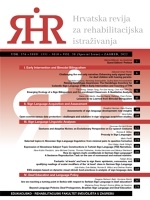Challenging the oral-only narrative: Enhancing early signed input for deaf children with hearing parents
Challenging the oral-only narrative: Enhancing early signed input for deaf children with hearing parents
Author(s): Deborah Chen PichlerSubject(s): Language acquisition, Educational Psychology, Inclusive Education / Inclusion, Pedagogy
Published by: Sveučilište u Zagrebu, Edukacijsko-rehabilitacijski fakultet
Keywords: sign language acquisition; deaf children; cochlear implants; bimodal bilingualism; early intervention; language input; infant perception;
Summary/Abstract: Learning a language is, at its core, a process of noticing patterns in the language input surrounding the learner. Although many of these language patterns are complex and difficult for adult speakers/signers to recognize, infants are able to find and learn them from the youngest age, without explicit instruction. However, this impressive feat is dependent on children’s early access to ample and well-formed input that displays the regular patterns of natural language. Such input is far from guaranteed for the great majority of deaf and hard of hearing (DHH) children, leading to well-documented difficulties and delays in linguistic development. Efforts to remedy this situation have focused disproportionately on amplifying DHH children’s hearing levels, often through cochlear implants, as young as possible to facilitate early access to spoken language. Given the time required for cochlear implantation, its lack of guaranteed success, and the critical importance of exposing infants to quality language input as early as possible, a bimodal bilingual approach can optimize DHH infants’ chances for on-time language development by providing them with both spoken and signed language input from the start. This paper addresses the common claim that signing with DHH children renders the task of learning spoken language more difficult, leading to delays and inferior language development, compared to DHH children in oral-only environments. That viewpoint has most recently been articulated by Geers et al. (2017a), which I will discuss as a representative of the many studies promoting an oral-only approach. Contrary to their claims that signing degrades the language input available to DHH children, recent research has demonstrated that the formidable pattern-finding skills of newborn infants extends to linguistic cues in both the spoken and signed modalities, and that the additional challenge of simultaneously acquiring two languages is offset by important “bilingual advantages.” Of course, securing early access to high quality signed input for DHH children from hearing families requires considerable effort, especially since most hearing parents are still novice signers. This paper closes with some suggestions for how to address this challenge through partnerships between linguistics researchers and early intervention programs to support family-centered bimodal bilingual development for DHH children.
Journal: Hrvatska revija za rehabilitacijska istrazivanja
- Issue Year: 58/2022
- Issue No: Spec. Iss.
- Page Range: 6-26
- Page Count: 21
- Language: English

